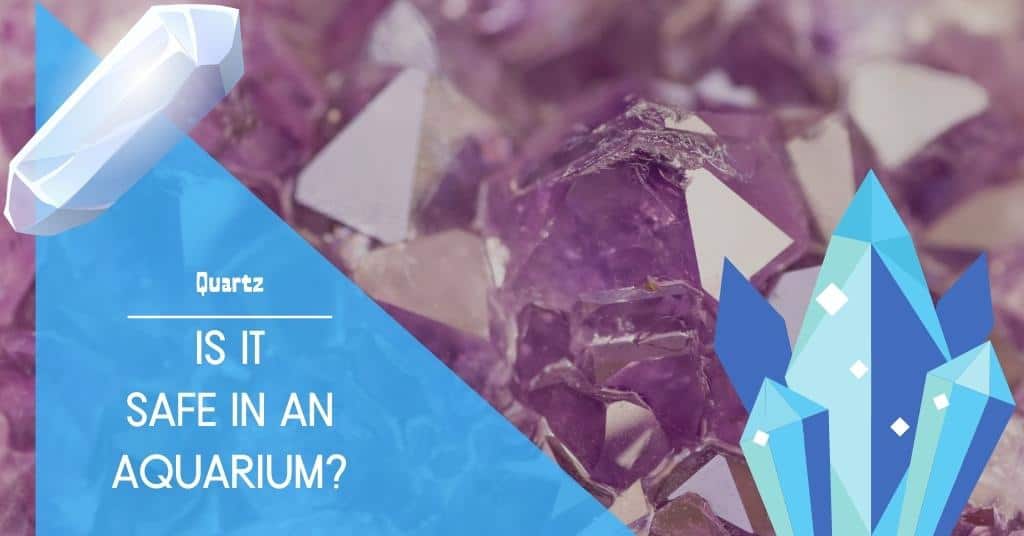Last Updated on March 24, 2023 by cmoarz
Updated 3/24/2023
Many aquarium enthusiasts wonder if it’s safe to use quartz in their aquariums. Will quartz rocks cause any issues with water parameters or harm fish? And what about other crystals? In this article, we’ll explore the safety of quartz and other crystals in aquariums, their potential benefits, and impact on water quality.
Quartz in Aquariums: A Beautiful Addition with Some Precautions
Table of Contents
Quartz is undoubtedly an attractive stone, and it’s easy to understand why people want to include it in their aquarium designs and aquascapes.
While quartz is generally safe for aquariums, there are a few things you should be aware of before adding these stunning crystals to your aquatic environment.
Preparing and Cleaning Quartz for Aquariums
Before adding quartz to your aquarium, it’s essential to clean and prepare it properly. Use a soft brush to scrub the stone and remove any dirt or debris.
Boil the quartz for a short period to eliminate potential contaminants. Ensure the stone has cooled down before placing it in the tank.
Quartz Rocks in Aquariums: Safety Concerns and Precautions
For the most part, quartz rocks are safe for aquariums and fish. However, there are a few exceptions and precautions you need to consider before introducing quartz to your tank:
- Copper content: Quartz rocks may contain copper, which is safe for most fish species. However, copper can be deadly for snails, shrimp, and other gastropods and crustaceans. Copper in quartz can also react with certain aquarium medications, potentially causing algae blooms.
To mitigate the risks associated with copper, choose quartz rocks with low copper content or apply an aquarium-safe sealant to the rocks.
- Quartz hardness: Quartz is harder than glass (with a MOHS hardness rating of 7 compared to glass’s 5.5 to 7). As a result, quartz can easily scratch and damage glass aquariums. To prevent this, place a layer of sand or aquarium gravel beneath the quartz and position the rocks in the center of the tank instead of against the glass.
Benefits of Using Quartz in Aquariums
Quartz and other safe crystals offer several benefits when used in aquariums:
- Aesthetic appeal: The unique and vibrant appearance of quartz can enhance the visual appeal of your aquarium.
- Hiding spots: Rocks and crystals can create natural hiding places for fish, making them feel more secure in their environment.
- Surface for beneficial bacteria: Quartz and other stones provide surfaces for beneficial bacteria to colonize, contributing to a healthy and balanced ecosystem within the tank.
Other Crystals for Aquariums: Safe and Unsafe Options, Benefits, and Precautions
If you’re considering adding other crystals to your aquarium, it’s essential to know which are safe and which are not. Here’s a list of safe and unsafe crystals for aquariums, along with their potential benefits and precautions:
Safe Crystals for Aquariums:
- Crystalline Quartz
- Amethyst
- Citrine
- Rose Quartz
- Smokey Quartz
- Granite
- Microcrystalline Quartz
- Jasper
- Agate
- Sard
- Jade
- Petrified Wood
- Onyx
- Slate (cleaned, may sometimes contain fossils)
Remember to clean and prepare these crystals properly, as mentioned earlier for quartz.
Unsafe Rocks and Crystals for Aquariums:
- Coal
- Dolomite
- Limestone
- Sandstone
- Pyrite
This list is not exhaustive but covers the most commonly asked-about rocks and crystals.
Monitoring Water Parameters When Using Crystals in Aquariums
After adding quartz or other safe crystals to your aquarium, it’s crucial to regularly monitor water parameters, such as pH, hardness, and copper levels. This will help ensure a healthy environment for fish and other aquatic life. Regular monitoring will also allow you to detect and address any potential issues that may arise from the addition of crystals to your tank.
H2: Visual Examples: Incorporating Quartz and Other Crystals in Aquariums
Including images of aquariums featuring quartz and other safe crystals can give readers a better idea of how these stones can enhance the appearance of their tanks. Images can also serve as inspiration for creating unique aquascapes. Consider providing pictures of various aquarium setups that incorporate quartz and other safe crystals, showcasing their aesthetic and functional benefits.
Conclusion
Incorporating quartz and other crystals into your aquarium can provide both aesthetic appeal and functional benefits, such as hiding spots and surfaces for beneficial bacteria. By carefully selecting, preparing, and placing these stones in your aquarium, and by regularly monitoring water parameters, you can create a beautiful and healthy environment for your fish and aquatic life.
Remember, it’s always better to be safe and informed about the items you add to your aquarium, as the health of your fish and the stability of your tank depend on it. Conduct thorough research and consult expert advice if you have questions or concerns about introducing specific crystals to your aquatic environment.
About
Owner of AquariumGravel.com and also owner of actual Aquarium Gravel believe it or not! ;). Setting up beautiful aquarium sceneries and habitats since I was very young. Enjoy!
- Web |
- More Posts(290)

